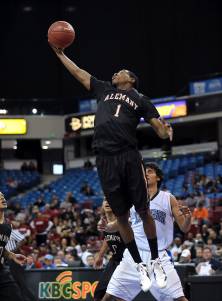With knee injuries becoming increasingly worse, the key is to condition and strength train for healthy knees.
After the first two 2012 NBA playoff games, fans were in shock at the two non-contact anterior cruciate ligament knee injuries that they witnessed.
Derrick Rose of the Chicago Bulls, the league's 2011 Most Valuable Player, and promising rookie Iman Shumpert of the New York Knicks were both lost for the next six to eight months. This presents a very scary case for basketball players and athletes of any skill level or any age.

Knee injuries are an all-to-familiarpart of basketball. Single-leg exercisescan strengthen the knee and helpprevent ACL injuries.
Photo by David Steutel
The demands of athletic performance have gotten so great in parallel to athletes becoming bigger, stronger and faster that what once was a freak injury is now too commonplace.
Before we can prevent it we must first identify what the ACL actually is: the anterior cruciate ligament is a vital knee stabilizer that actually has a greater role in securing the back of the knee than the front.
While ACL injuries are more common in women, the story remains the same. As an athlete starts or lands, the top of the leg continues to move forward while the lower leg stabilizes on the ground or shoots backwards. This puts tremendous strain on the ligament.
So, what's the answer to preventing and decreasing these injuries? Is it the need for more braces or higher sneakers?
Not likely, as they actually reduce joint mobility and increase the chances of injuries in the long term.
The greatest weapon to combat these injuries is with proper strength and conditioning.
Step 1 is to increase one's single leg strength. All sports take place on a single leg. While the base might be on two legs, explosive movements happen on single legs.
As a result, training with various single leg exercises, such as dumbbell step ups, split squats, single leg squats and single leg deadlifts, is crucial. Not only do these movements increase single leg strength but they also help increase stability once an athlete lands or stops.
Step 2 is to stretch properly and stretch the right muscles. The focus should be on the quadriceps, hip flexors and hamstrings. These are the most frequently injured and tight muscles, so it's wise to stretch them after a nice hot shower for at least 15-20 minutes.
Step 3 is to follow a proper anti-inflammatory diet. If athletes are consistently eating too much junk food, they are decreasing muscle, tendon and ligament strength. The focus should be on grass-fed or organic meat, chicken and wild caught fish.
In addition, consuming an omega-3 rich diet by eating healthy fat options like almonds or walnuts is important. While many scholastic athletes probably dread vegetables, try to include one serving with dinner while making sure to eat at least one serving of multiple colored fruits per day.
It's an old and played-out saying, but we really are what we eat. Make sure to put the right fuel in and train smarter and athletes will eliminate the chance of knee injuries.
Jimmy Smith, MS, CSCS is a performance therapist and trainer who works with athletes of all levels. For more information visit his website at basketballstrengthworkoutsandnutrition.com